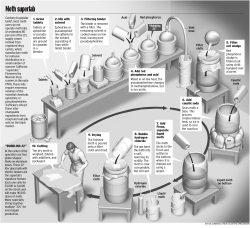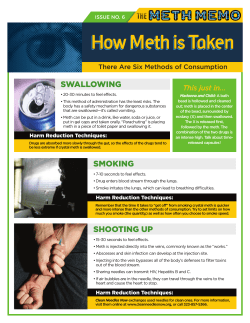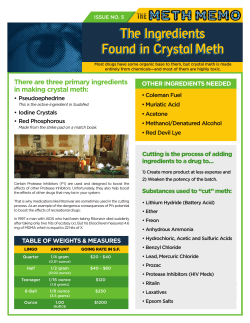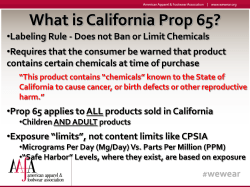
Methamphetamine NYS Southern Tier + Pennsylvania Northern Tier = “Meth Valley”
Methamphetamine NYS Southern Tier + Pennsylvania Northern Tier = “Meth Valley” What is Methamphetamine? Methamphetamines are stimulants that are produced and sold illegally in pill form, capsules, powder and chunks that can be injected, snorted, taken orally, or smoked. An amphetamine is a chemical that has stimulant properties similar to adrenaline. It gives the user a "rush" or intense feeling of pleasure that lasts longer than cocaine. Methamphetamines may be known as meth, crank, glass, speed, crystal, ice, batu, chalk, shabu, or zip. Methamphetamines stimulate the central nervous system, and are extremely addictive. Long-term use leads to physical dependence. Meth may give a person periods of high energy and rapid speech. Many chronic meth users also experience severe depression, delusions, hallucinations, paranoia, and violent behavior. You should never enter an active meth lab. Contact your local law enforcement immediately. Instances of methamphetamine trafficking and abuse in the United States are on the increase. As a result, this drug is having a devastating impact on communities across the nation. The problem is rapidly increasing in this area. How is Meth made? Clandestine production accounts for nearly all of the methamphetamine sold and abused in the US. Methamphetamine is clandestinely manufactured using the ephedrine or pseudoephedrine reduction method. In this process, over-thecounter cold and allergy tablets containing ephedrine or pseudoephedrine are placed in a solution of water, alcohol, or other solvent for several hours until the ephedrine or pseudoephedrine separates from the tablet. Then, using common household products and equipment, and a recipe learned from friends or taken off the Internet, the ephedrine or pseudoephedrine is converted into high quality Methamphetamine in makeshift, illegal labs by untrained individuals. Household products contain most of the necessary chemicals to complete the manufacturing process. Certain brands of drain cleaner have a high concentration of sulfuric acid. When mixed with salt, hydrogen chloride gas is produced for use in the final stage of meth production. The hydrogen chloride gas procedure as well as other procedures are extremely dangerous and can cause death or serious injury not only to the individuals making the meth, but to others who may be living in an adjoining house or apartment. The chemicals used to make meth are toxic, and the lab operators routinely dump waste into streams, rivers, fields, and sewage systems. The chemical vapors produced during cooking permeate the walls and carpets of houses and buildings, making them uninhabitable. The cost of cleaning up a structure that housed a meth lab requires specialized training and can range anywhere from $3,000 to $100,000 — and the owner may be liable for the cleanup. Common Chemicals Used to Make Methamphetamine: Alcohol (Isopropyl or rubbing alcohol) Toluene (brake cleaner) Ether (engine starter) Sulfuric Acid (drain cleaner) Red Phosphorus (matches/road flares) Salt (table/rock) Iodine (flakes/crystal) Lithium (batteries) Trichloroethane (gun scrubber) MSM (cutting agent) Sodium Metal Methanol/Alcohol (gasoline additives) Muriatic Acid Anhydrous Ammonia (farm fertilizer) Sodium Hydroxide (lye) Pseudoephedrine and Ephedrine (cold tablets) Acetone Cat Litter Typical Equipment Used to Make Methamphetamine: Pyrex or Corning dishes (glass) Jugs/bottles Paper towels, coffee filters Thermometer Cheesecloth funnels, blenders rubber tubing/gloves, pails/buckets, gas cans, tape/clamps, internet documents/notes "How to Make Methamphetamine" books Aluminum foil Propane cylinders (20-lb) Hotplates plastic storage containers/ice chests measuring cups towels/bed sheets laboratory beakers/glassware Where is Meth made? Meth is often made in makeshift laboratories, such as rented apartments or hotel rooms. It can be made in garages, tool sheds, kitchens, basements, car trunks, the back of a pickup, even in the woods or open fields. During the production of meth, a property can become contaminated with hazardous chemicals. Many people may be unaware that they're living near a meth lab. Here are some things to look for: Unusual, strong odors (like cat urine, ether, ammonia, acetone or other chemicals). Residences with windows blacked out. Renters who pay their landlords in cash. (Most drug dealers trade exclusively in cash.) Lots of traffic - people coming and going at unusual times. There may be little traffic during the day, but at night the activity increases dramatically. Excessive trash including large amounts of antifreeze containers, lantern fuel cans, red chemically stained coffee filters, drain cleaner, duct tape Unusual amounts of clear glass containers being brought into the home. As a result of meth "cooking", many chemicals may contaminate a property. Some household materials, such as carpeting, wallboard, ceiling tile, or fabric, may actually absorb spilled chemicals. Furniture or draperies may also become contaminated. Soil or groundwater (including nearby drinking water wells) may become contaminated if chemicals are dumped in a septic system or on the ground. What happens after a meth lab is discovered? When a meth lab is discovered, the local law enforcement agency is responsible for making arrests and seizing the lab. Evidence is removed from the site, and chemical hazard consultants are brought in by law enforcement to remove containers of hazardous chemicals related to the operation of the meth lab. Officials will also screen indoor air. Law enforcement may call child protective services if children are involved. Will exposure to chemicals in a meth lab result in harmful health effects? While still in operation, or prior to a seizure, there is a high risk for acute exposure to harmful chemicals in meth labs. If you discover an active meth lab, do not attempt to enter. Contact your local law enforcement agency immediately. Many of the chemicals used in the "cooking" process can be harmful. Short-term exposures to chemical vapors in a functioning meth lab can cause severe health problems or even death. Meth "cookers", their families, and first responders are at highest risk of acute health effects from exposure, including lung damage and chemical burns. Heating solvents inside a building can create a highly flammable situation; meth labs are often discovered when fire fighters respond to a blaze. Whether in their raw form or after they've been 'cooked' into finished drugs, touching these chemicals or just breathing their fumes can cause fainting, sickness or permanent injury. The chemicals used to make meth can damage the central nervous system, liver and kidneys, and burn or irritate the skin. Long-term exposure can cause cancer, short-term and permanent brain damage, and immune and respiratory system problems. A team effort: Meth labs require law enforcement to partner with the local fire department and EMS. When executing a raid on a known meth lab, fire fighters and paramedics must know that it's a meth lab, what the structure is like inside, what chemicals may be present, and how many people they may be dealing with, so they can come prepared. Often officers enter these labs wearing tyvek suits and latex gloves, believing they provide adequate protection. But neither item offers much protection in a meth lab. What to do: While officers may be aware of the chemicals the process began with, they may not know what stage the cook is in and what chemicals they are dealing with now. What they have is an unknown hazmat spill, and that's exactly how it must be dealt with. Anytime you're dealing with a lab it's a hazmat situation. If a patrol officer comes upon a lab while responding to a call, experts advise getting out and trying to get the occupants to leave as well. "Find a way to dupe the suspects outside, arrest and drag them out, but get out. The risk of explosion, fire and contamination is just too great." Do not use weapons or flash-bangs, or even flick on the lights. Doing any of these things in a lab might trigger an explosion or cause a fire to erupt. Do not touch anything. If you run your hand along a couch in a lab, then rub your eyes, you are contaminated. Do not interfere with a cooking operation, unless you've been trained to do so. Some people believe that if they turn things off in a hot lab, the situation becomes safer and the chemicals less volatile. But that's not always the case. Some things get worse as the chemicals cool. The cardinal rule is: Turn nothing on, turn nothing off. If you interfere with the process, you may be prompting an explosion or fire. Three guiding rules of EMS must be remembered when dealing with clandestine methamphetamine labs (CMLs): Your #1 goal is always life safety. Stabilize the scene for public safety. Protect the environment . Here are ten steps to consider for your continuing safety: 1. Slow down! Stop and count to ten when you arrive on any scene. Use those ten seconds, and extreme caution, to really visualize and recognize everything you see and smell. Meth labs are highly toxic and inflammatory, and cooking meth is a highly volatile process. Eliminate ignition sources, static, and radios. Don't smoke! 2. Don’t go into the house if you think it might be a meth lab! Never turn off electricity or propane. If the methcooking process is disturbed or interrupted, an explosion can result. And some things get worse as the chemicals cool. Be alert for booby traps, such as ether in a jar on a window sill. Opening or moving it can cause an explosion. The cardinal rule is: Turn nothing on, turn nothing off. If you interfere with the process, you may be prompting an explosion or fire. 3. Avoid touching contaminated victims or anything in the lab. Don't eat, drink, or wipe your sleeve across your face on-scene. As soon as meth enters your body, whether through skin or breathing, you are contaminated. Decontamination and detoxification will be necessary. When individuals leave a meth lab they carry contamination with them, thus crosscontaminating innocent people. Chemicals can cling to their clothes, drop from their footsteps, and be absorbed by their skin. Responders often enter these labs wearing tyvek suits and latex gloves, believing they provide adequate protection. But neither item offers much protection in a meth lab. And while responders may be aware of the chemicals the process began with, they may not know what stage the cook is in and what chemicals they are dealing with now. To properly decontaminate victims and any contaminated crewmembers on-scene: Devise some sort of privacy shield. Have them undress (bag their clothing). Flush them with running water for 15 minutes using 10 gallons a minute. Have them scrub vigorously. If decontamination of victims or exposed crew is ignored, EMS can transfer the problem into their own ambulances, fire trucks, or private vehicles. That can effectively shut down the EMS service. If not properly isolated and decontaminated, a contaminated victim can shut down a hospital emergency department, too. Don't carry contamination home with you on your clothing. 4. Recognize what you observe in the “hot zone.” Shut the door and begin stabilizing the scene. Protect the chain of evidence, stay out of it, and don't crosscontaminate. 5. Don't step on discolored ground that's devoid of plants. Your shoes aren't the non-absorption type necessary to your safety if you step in byproducts of the meth cooking process. Ambulance crews also don't wear appropriate repellent clothing or use proper breathing apparatus for entering active meth labs. 6. Your hardest challenge will be to back off and let a screaming person inside a burning building (or vehicle) die. 7. If a meth cook is taking place you can figure that someone is going to die. Don't let it be you! Carbon monoxide exists in hot cooks and people in clandestine meth labs can collapse and die. Children are especially at high risk. If you must go inside, get in and out as quickly as possible. Drag the victim outside before giving care. If safely possible, vent the site, but stay upwind. And decontaminate. 8. Control the scene; optimize responder safety by minimizing crew. Create a defendable space and protect the public by moving bystanders away. Evacuate the area, moving everyone 330-660 feet away. Everything within that one-two city block area is the hot zone. Blockade access routes. These can become long-term situations. You're dealing with a vaporous gas, so don't go into low places, such as ditches or basements. 9. Ignore bystander's criticism. Their opinions are unsafe to you. You want to go home from a scene alive! 10. Involve appropriate agencies that will engage cleanup experts. http://www.nlm.nih.gov/medlineplus/amp hetamineabuse.html CME Credit To receive a two-hour continuing education credit, print the quiz,mark your answers, and be sure your name and address are filled in. Send the test to EMSTAR – fax to 732-2661 or mail to 1058 West Church Street, Elmira NY 14905 Your quiz will be checked for correct answers and a certificate mailed to you.
© Copyright 2025





















